First, a salute to Baron Samedi:

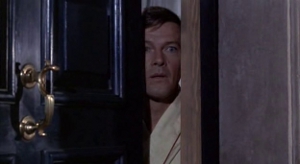
Great Tracy’s ghost, it’s finally here! The debut of Roger Moore, the Third and Longest-Lasting Bond (so far), who’ll carry the weight of these next seven films for a very long time. I feel like a kid at Christmas because the Moore Era contains some of the series best and worst, irrevocably cementing Bond’s place in modern cinema as a character who’d outlive his actors….for better and worse…
Where Connery feared the role would dominate his career, Moore came to it already “groomed” by eight years as TV’s The Saint. He seemed to embrace that….despite having to cut his hair and loose some weight for this part. He’d packed it on and let it grow out during his disastrous slow-motion train wreck of a TV show The Persuaders! (Yes, the exclamation point’s part of the title – whaddya expect? It was the 70s.) At that point, Moore could’ve helmed ten bad TV shows and people still would’ve flocked to their theaters to see him as James Bond in (a heavily altered facsimile of) Ian Fleming’s Live and Let Die.
And thank Baron Samedi they changed everything they could about the novel, which practically bleeds upper-crusty, mid-20th century racism…though, as we’ll see in eight films, it did contain one very memorable shark scene…Breaking from the books is nothing new to this franchise, but there’s a good bit of superficial breaking with Franchise Formula here. Bond smokes cigars instead of cigarettes, drinks bourbon instead of martinis, and there’s a patent avoidance of any “pass the torch” scene, like when the Second Bond cleaned out his desk in On Her Majesty’s Secret Service.
It’s as if Eon Productions feared exactly what we discussed last time: stagnation. They hoped the entire film – not just Moore – would bring a new energy to Bond and win back the audience they felt they’d spent the 50s and 60s loosing to television.
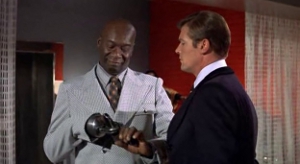
To a point, they were right on both counts as Roger Moore brings more wry charm to the role that Connery ever did, simultaneously making Bond less threatening and less human. I joke about Connery being a proto-Terminator, but his Bond was always quick with a smile, had no trouble making polite conversation and even less trouble getting pissed…especially when The Villain killed a colleague or three. Moore’s Bond approaches everything with either a knowing smirk or a knowing parody of surprise, like a man holding all the cards…which he certainly does. But that’s because – both within the movie and without – the deck’s stacked in his favor. Live and Let Die is the Bond series hedging its bets, going for the surest thing that happened to be on the table at the time. So Bond is still just the same neigh-invulnerable hound, but this time he’s stuck in…a Blaxploitation movie…?
….?
I kid. This isn’t so inexplicable if you read the novel…which, as already mentioned, you shouldn’t. And besides, this movie came out in 1973 – two years after Shaft and Sweet Sweetback’s Baadasssss Song defined the Blaxpoloitation movie as a thing (if not yet a sub-genre) – with Black Caeser, Coffy and Detroit 9000 already out or on the way. What else could the producers do? Come up with something original? Bah…humbug!
In a way, they did, transmuting the novel’s Soviet gold smuggler villain into a passable pastiche of Poppa Doc Duvalier. After three movies worth of Blofeld, seeing Double-O Seven square off against someone – anyone – else is a treat. But seeing him square of against Yaphet Kotto? That’s a genuine godsend. This being right after his role as a Joe Friday clone in Across 110th Street, you can tell Kotto’s having the time of his life being a Bond villain and I love every scenery-chewing minute of it…even the ones with what’s now called the “Unnecessarily Slow Moving Dipping Mechanism.”
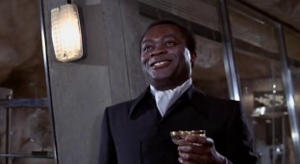
Kotto plays Dr. Kananga, dictator of the (fictional) Caribbean island of San Monique…which, despite its French name, somehow falls under the jurisdiction of MI6. I guess it could’ve changed hands after what everyone but my country calls The French and Indian War. Anyway, in quite the Dr. No call-back, three British agents observing Dr. Kananga’s operations in New York, New Orleans and San Monique “simultaneously” catch their death during the pre-credit sequence. M (still Bernard Lee) and Miss Moneypenny (still Lois Maxwell) task Bond to investigate…at his home. In the middle of the night. As he struggles to hide the Italian agent who slipped back to England with him.
Much is made of this first view of Bond’s private space and it is nice to see…eight films in…but I don’t see much point to it outside introducing Bond in bed with a hot chick (breaking the “introduce Bond in action” bit of the Formula) and breaking up the monotony of your Usual Briefing Scene for the second time in two films (by having it somewhere other than M’s office). That’s more than enough for it to handle without adding to Bond’s character…though we see he has a cappuccino machine. Did he just get that in Italy?
Some see it as a conscious distancing of Moore’s Bond from Connery’s but I don’t know…after what happened to Lazenby, it makes more sense to assure us that, yes, this is the same character we’ve seen for eight movies…now in an exciting, new Roger Moore flavor! The film does this through M and Moneypenny, who react to him exactly the same as they reacting to the last two Bonds, but also through the way Bond kills and shags his way through every other woman in the film, be they good or evil.
That’s also why so much of Live’s first act resembles Dr. No, with Bond being tailed by henchmen from the moment he gets out of JFK airport. And while this is a sign of sequelitis, I don’t mind it so much when the end product is well-made. And I’d argue Live and Let Die is well-made in almost every technical sense, though that does not equal “great” or even really “that good.” But it, like Sidney Lumet’s The Offense, is also unquestionably better than Diamonds Are Forever.
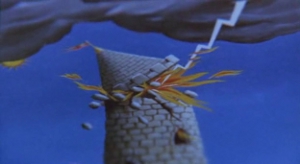
The tailing (and assassination of his taxi driver) lead Bond to the Fillet of Soul restaurant in Harlem, secretly owned by the notorious gangster Mr. Big. We’re meant to be fooled by Yaphet Kotto’s horrible make-up job and full-on stereotypical gangster persona (“Ya’all take this honkey out and waste ’em.”) but even at the ripe old age of eight I couldn’t help but wonder “What’s all that crap doing on Parker’s face?”
Saving himself from being wasted, Bond hooks up with CIA Agent Harold Strutter (Lon Satton) and our Fifth Felix Leiter (David Hedison), who may be my favorite Felix of the series, besting even the man who defined the role, Jack Lord, because of the way he shouts, “Get me a make on a white pimpmobile!” at his subordinates. It’s a small part in a big, sprawling crime story, but Hedison leaves more of an impression than any Leiter I’ve seen yet.
Felix 5 ships Bond out to San Monique, where the film finally starts to go downhill by falling back on Formula as our Dead Bond Girl Walking, novice CIA Agent Rosie Carver (Gloria Hendry), flips into the picture. Within ten minutes she’s screamed twice at incredibly silly things and declared herself useless. We can only agree, but by playing a double agent – spoiler alert for a film you should’ve all seen as children – Hendry risks annoying the shit out of the audience by playing her character as useless. She and the film loose because her naivete’s played for comedy until some switch flips and she becomes the world’s worst double agent. It’s like director Guy Hamilton told her “act like a bad actress” which is one of those things that can cause an actor’s brain to collapse in on itself if you’re not careful.
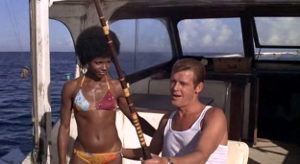
Luckily, we’re only with Rosie for ten minutes before she’s killed by a gun mounted in one of the scarecrows Kananga uses to guard his property. Why he doesn’t immediately kill Bond as Our Hero stands over Rosie’s corpse…we’ll never know. Why he employed Rosie as a double agent when some drugged champaigne glasses would’ve served as well, proved far more reliable and been less annoying…we’ll never know that either. Chalk it up to the great mysteries of Bond Villainy, which has a logic unrelated to our Earth-logic. Its mysteries are grand and deep, like the human capacity for violence or Bond’s capacity for sex.
In this case, Kananga plans to grow acres of opium poppies and, in his secret identity as Mr. Big, flood the market with free heroin through his chain of soul food restaurants. This will – he claims – depress drug prices, bankrupt his competitors and leave him with a clean market to sweep up…at inflated prices, of course. Avon Barksdale would not approve as any good drug dealer knows you can’t expect brand loyalty from drug addicts! Besides, what does becoming a drug lord in the US accomplish when you’re already the leader of a small island nation? The real Poppa Doc just sat back in his presidential palace and transferred US aid money into his private bank accounts – a quicker, simpler and much easier way to steal billions of dollars.
So we’ve got a smirking Bond vs. a overly-complex supervillain with a hair-brained scheme full of holes and an over reliance on his psychic Tarot reader, Solitaire (Jane Seymour)…whom Bond inevitably seduces and must spend the rest of the movie protecting. At least the actions improved over the last movie. This has something the series has lacked for awhile: build-up. It starts with those three pre-credit deaths and piles action on itself until the boat chase an hour and twenty minutes in. It’s obviously meant as a long-form version of the boat chase that concluded From Russia with Love…except Bond’s alone and Kananga/Big’s henchmen are chasing him through the swamps of Louisiana…and it’s twelve minutes long.

It’s like screenwriter Tom Mankiewicz sat down, watched all the Bond films he didn’t work on, and attempted to top all the previous series highlights he liked best. Instead of one guy tailing Bond through an Exotic Foreign Location, every black person in Harlem, San Monique and New Orleans seems to be on Mr. Big/Kananga’s payroll. Instead of a couple sharks, Kananga/Mr. Big orders Bond dropped off in the middle of his alligator army (but don’t worry, shark fans – you get some chum too). Instead of setting up all their gadgets in the opening scene, Bond’s watch miraculously develops a buzz saw function just as he and Solitaire are about to be (slowly) dipped into shark-infested waters. And once again we’re back to a Bond who can unironically seduce the Villain’s henchwomen by whatever means necessary – instantly converting the unrighteous with his cock. It’s if Mankiewicz failed to realize Fiona was being snide when she gave that little speech back in Thunderball. Instead, he used it as his template.
Topping all that off, this boat chase is unnecessarily padded with the first genuine piece of Odious Comic Relief of the franchise – Sheriff J. W. Pepper (Clifton James). His Loud Southern Lawman archetype was not as popular as it would become later, but something about it obviously tickled Mankiewicz’s funny bone. I suspect he’d never faced down an actual Loud Southern Lawman or he would’ve known how astonishingly humorless they are when they’re in a position to call someone “boy”…even today.
I get it. Mankiewicz obviously didn’t get the “driving while black” speech when he turned sixteen, like some of us. Fine. I can always bitch about the flagrant tonal shift this chase represents, at what should be the emotional high point of the film. Even without Sheriff Pepper, Bond and the henchmen chasing him blow through an enormous amount of classical slapstick set-pieces on their way to the Climactic Explosion, even trashing a wedding.
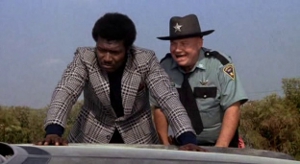
Up until this point, the film’s been a stylized espionage/drug trafficking thriller, with some shadings of the supernatural thrown in because Kananga uses voodoo rituals to keep the locals in line and away from his poppy field…and dispose of the occasional foreign agent. With this chase (actually, I’d argue it starts with Bond’s escape from Crocodile Island) the film becomes a light-hearted romp where only bad people die and the worst we can say about the good people is “they’re racist shitkickers.” That’s a lot worse of a thing to say now than it was in 1973…and for that, I’m thankful. Doesn’t make Sheriff Pepper any easier to stand. Hell, I find most chase scenes to be superfluous and boring anyway…though I do like Pepper’s line to Bond:
“What are you…? Some kindof a…doomsday machine, boy?
Yes, Sheriff. Exactly.
In the plus column, Guy Hamilton’s direction has improved since last time, and he’s begun to use some real tricks. Early on, the way he intercuts scenes of Strutter talking to Felix with scenes of Mr. Big’s people talking into their hidden microphones (including the shoe-shine boy in the corner), we’re meant to think Strutter’s one of Big’s henchmen, maybe a little higher up than most. This is also meant to undercut any charge of racism since the filmmakers can point to Strutter and say, “See? The CIA have their own black guy!” Not that this helped, of course.
Now, Mr. Big’s henchmen – they help by being memorable characters who (over the course of the film) do things to make you like them. Except Whisper (Earl Jolly Brown). I’m not sure what’s up with him. I know what’s up with Julius Harris’ Tee Hee Johnson because he tells us – a crocodile took his arm, so he replaced it with a metal prosthetic, complete with crushing claw hand – making Tee Hee the first genuine cyborg of the Bond franchise. Body-mod lovers, screw all the rest: this is your James Bond film. And while Harris doesn’t get much more to do than tell his story to Bond and die in the by-now-obligatory post-climax attempt on Bond’s life, his presence is downright infectious. He smiles like a henchman secure in his position.
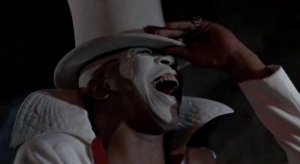
We find Geoffrey Holder with even less to do as the Baron Samedi, save dance around, laugh a lot, and get thrown into a coffin full of snakes. Yet Holder’s laugh manages to make him a more memorable henchman than anyone in Diamonds whose names weren’t Bambi or Thumper. These days I know that, not only is Baron Samedi one of the many, many loa in charge of guarding the gate to the lands of the dead, but also that he will, sometimes, refuse people entry, granting a species of functional immortality to either the very lucky or the very cursed. Knowing this, I can’t help but think Maybe that’s how Bond’s survived all these years! Baron Samedi just straight-up refuses to dig his grave.
Or maybe the quality of neigh-invulnerability inherent in ever pulp hero refuses to translate well to early-70s movie screens. At least Connery’s clothes and face suffered the occasional bit of battle damage. Moore’s Bond survives worse than Dr. No could ever dream of with nothing more than a pursed forehead and some glib observations. He’s funnier than Connery’s Bond, but that’s because he has better one-lines. He seems cockier than Connery, but that’s very much in-character. He’s survived more, and his adventure here is soaked in sweat and the grimy urban decay of a bombed-out, American inner city – about as far as you can go from Connery’s usual haunts in casinos and Ninja Academies.
Yet we still end up in an underground lair, with Bond evading a death trap before tricking the villain into one. We end up, despite all the hubbub heralding a new Bond, with a reliably middle-of-the-road spy-fi adventure, better than most, not so good as others. Its aesthetics uniqueness allows it to evade the border guards and slip into the land of Slightly Above Average. As a kid, it was one of my favorite Bond films, and I can still stand it today. If it’d been a little tighter, a little smarter, it could’ve challenged the best in this series. But the vast middle ground isn’t such a bad place to be either. Especially given the way things were going…and will continue to go.
![]()
![]()
![]()
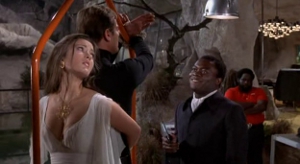

I loved this movie to an embarrassing degree as a kid. I still enjoy it based on nostalgia and the cast-Geoffrey Holder, Julius Harris and Yaphet Kotto, hell, even this film’s version of Leiter….but it’s pretty hard to defend it’s worst moments.
Also, if you haven’t seen this dubbed into French, you haven’t lived. I saw it that way on a family trip to Quebec as a kid, and, let me tell you, if it was strange to hear Bond called a honkey in English, it’s even more odd surrounded by French.
Now that would be what I call Comedy! I’m going to have to try that with the largest group of friends I can gather at the earliest possible opportunity.
The reason why this seems Dr.NO part 2 is because Fleming’s Live and Let Die was the precursor to Doctor No. Both books contain a villain who controls their henchmen by fear and superstition, both have the same allies who end up getting killed in their second appearances, and, most obviously, the villains’ bases of operations are in Jamaica.
Speaking of Roger Moore in general, if you watch all his Bond films you’ll realize that he never quite stayed the same under all the directors. In these Guy Hamilton films, he was light hearted but at times a real ass which is even more apparent in The Man With The Golden Gun. Under Lewis Gilbert, Moore was a bit more of a comic book superhero who could practically everything which included piloting a space shuttle. Under John Glen, Moore never lost his sense of humor but he became just a tad more serious than his previous incarnations due in part because his films became a little more darker in tone and also because Moore’s Bond started to take these villians a bit more seriously.
I know what you mean – on both counts. They moved things to Louisiana in order to avoid returning to Jamaica, right? I get the fake Caribbean Island thing (comic books use them whenever someone needs to beet up an expy of some dictator – see also, Fake Middle-Easter Dictatorships). And I’ll probably spend the rest of the Moore era cataloging these wonderful inconsistencies. I even like some of them.
Actually, that was Jamaica that they shot the “San Monique” scenes in. New Orleans was added because it does tie in with the black culture/voodoo atmosphere. Personally, I think original novel had more respect for the black culture than this film because Fleming went into great detail of the black culture in the 1950’s (Leiter actually ended up having a friendly discussion about Jazz artists with one of Mr. Big’s men) and the subject of voodoo. I think what can be taken as racist is Fleming’s suggestion that Black people have this deep seeded, primal fear of Baron Samedi which Big used to control his men. However, Cayman Islander Quarrel didn’t seem to think too much of Big.
By the way, this is the best non-John Barry Bond score ever.
Looking back on it, this film doesn’t really make a whole lot of sense to me, on several fronts. First, why is MI6’s top agent fooling around entirely in what would nominally be Secret Service/DOJ/CIA territory? Second, it seems more than a little silly that the lead in what is essentially a blaxploitation film is not only white, but British! Third, it just seems like one of two instances in which the 007 franchise inexplicably glommed onto other movie fads (Moonraker being the other). The Bond franchise used to inspire others to follow it (the Flint and Matt Helm films, for instance). Now they’re playing tagalong behind Shaft and Luke Skywalker?
(And to think that when I read out the opening credits to Superman, my voice tended to get that much more stentorian when I got to “Creative Consultant: Tom Mankiewicz”…)
Me, I wondered what the hell the CIA’s doing in Harlem at all. Domestic shit’s supposed to be under the NSA’s umbrella…though I think that’s to keep from confusing those happy few of us who remember Bond’s previous adventures…the Church Committee was two years in the future, after all.
As to the rest of it…yeah. It’s always sad to see a long running series decay into an “also-ran.” I’m not sure if it’s better to do that or desperately stretch for topical relevance. We’ve got not-Howard Hughes in Diamonds and how ’bout all those references to “the Energy Crisis” that pop up, starting with Man with the Golden Gun? Not dated at all, all they? Not one bit.
Technically, since Mr. Big’s enterprise operates partially outside of sovereign U.S. territory, that places it under the CIA’s jurisdiction, if I remember correctly about CIA rules.
I was willing to give Golden Gun a pass with respect to the energy-crisis angle, since every Bond film prior to Daniel Craig seems to date itself in some respect (Octopussy: the nuclear panic of the ’80s; Licence to Kill: the cocaine trade; The World Is Not Enough: Eastern Europe after the collapse of the Iron Curtain; etc.).
Yeah, you’re totally right on both counts. Connery’s first cycle drips with Cold War atmosphere and I wouldn’t have it any other way. And it’s not like the conditions that created the early-70s Crisis have suddenly disappeared. Lord knows supervillains are still turning “clean” alternative energy technologies into weapons of mass destruction…
But on the other hand, what do you think about the martial arts sequence in Golden Gun? Necessary story beats or gratuitous riding of Enter the Dragon‘s coattails? Personally, I never gave it enough thought to really arrive at a preference…until now, of course, since Golden Gun‘s next…but a majority of the Bond fans I’ve encountered (on the internet) lean toward the latter reading.
Hmm… Leaving the Enter the Dragon comparison aside (I last saw a Bruce Lee film when I was maybe eight, and I’m not sure if that was it), the martial-arts sequence did seem a bit out of place. It’s at least short, and it’s not the worst such offense this film commits–that honor goes to a certain vacationing Louisiana sheriff (talk about jurisdictional issues…). I think it’s basically an attempt to fill the hand-to-hand combat quota more than anything else.
I know everyone hates “Jay Dubya” but I actually did enjoy the fact he was in the car with Bond during the Scaramanga chase and yelling at everyone else to get out of the way.
Don’t forget all the martial arts in Man with, surely designed to cash-in on the success of Enter the Dragon.
I’ll admit I kinda did, if only because everyone’s already commented on them…and I’ve never had any problem with Lt. Hip’s nieces. In a post-Bambi and Thumper world, they two aren’t really all that jarring, especially since Bond’s already in the Far East. Compared to the Tiger Tanaka’s Secret Ninja Academy, they’re practically low-key.
In the film’s defense, Fleming had to do logical gymnastics in order to convince the reader that MI6 agents are needed to do jobs that really shouldn’t concern them. As a matter of fact, very few of Fleming’s Bond tales have anything to do with any sort of real espionage work; Casino Royale, From Russia With Love, and On Her Majesty’s Secret Service are just about the only ones that really justify the need of a spy as the main protagonist.
That’s a good point, and probably the key to Bond’s widespread influence over the modern action genre. We believe he can do all these extraordinary things and survive because he’s a spy, but his spy-ness is largely incidental to all about the extraordinary things he does to survive…unless and until his watch needs to grow a buzz saw. So “spy movies” become these gadget-focused excuses in sneaking science fiction past people who claim not to like science fiction, while “action movies” become James-Bond-films-without-James-Bond.
So what you’re saying is that MI6 should hire Inspector Gadget.
(If I should give anyone reading that nightmares, my apologies.)
I could see the Gadget Bond team up in the Moore era.
I don’t think Fleming ever once thought of James Bond as a spy; More like a masculine bastard who goes on wild adventures that men would envy.
I’d rather live and let die that diamonds are forever. Roger Moore the best way to start your career as james bond
My sentiments exactly.